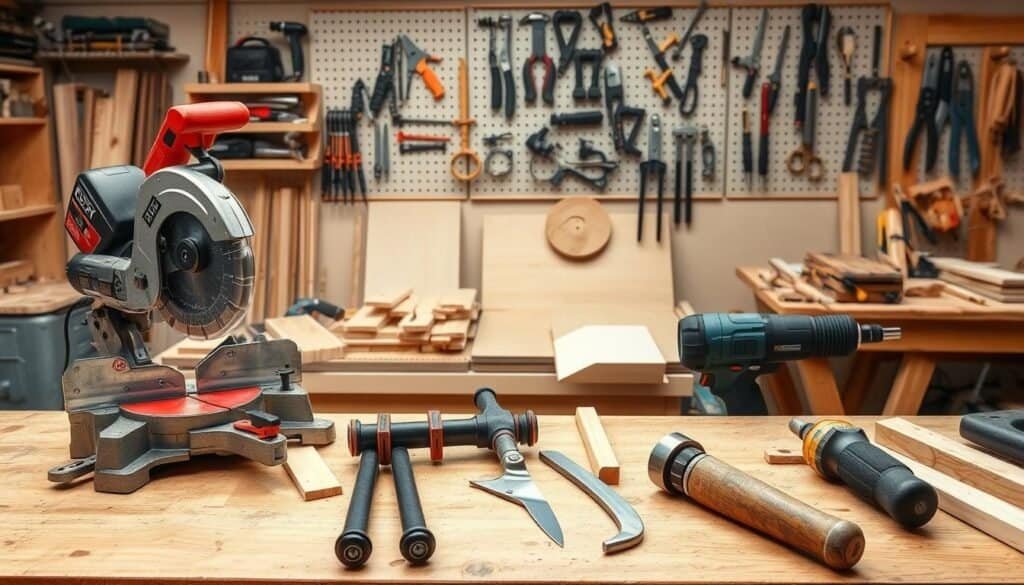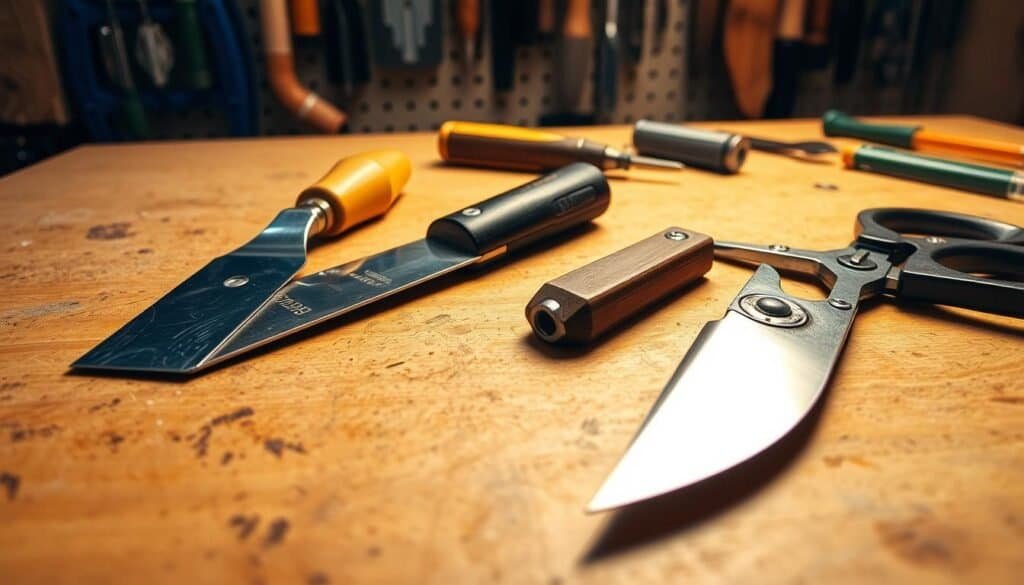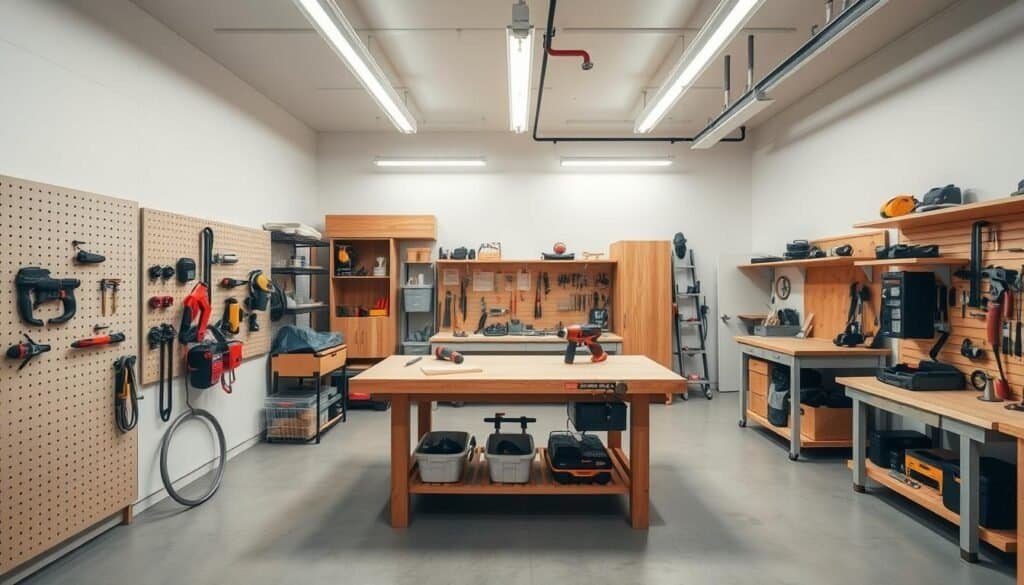Having the right tools is key for any woodworking project, as Kreg Tool points out. Whether you’re an experienced carpenter or a DIY beginner, your work quality depends on your tools.
An ultimate list of woodworking tools should cover a range of instruments. These tools help you work with precision and speed. In this article, we’ll explore 20 essential tools for every woodworker.
Our list includes everything from basic hand tools to specialized gear. It aims to give you a full view of what you need to improve your woodworking projects.
Why Every Woodworker Needs the Right Tools
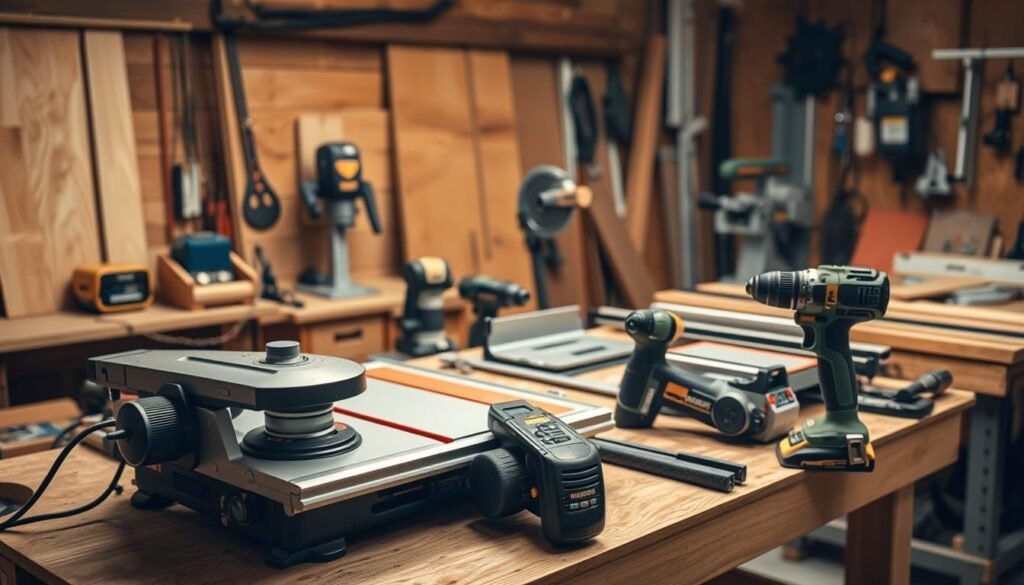
The right tools are key to a woodworking project’s success. Joshua Farnsworth says traditional woodworking needs proper hand tools. These tools are vital for precision and detail.
Having the best tools improves your work’s quality and saves time. Top woodworking power tools, for example, make complex tasks easier. This lets woodworkers focus on the details.
A good set of tools is essential for any project. Whether you’re new or experienced, a guide to top woodworking equipment is helpful. It helps you choose the right tools for your needs.
Getting Started: Basic Hand Tools for Beginners
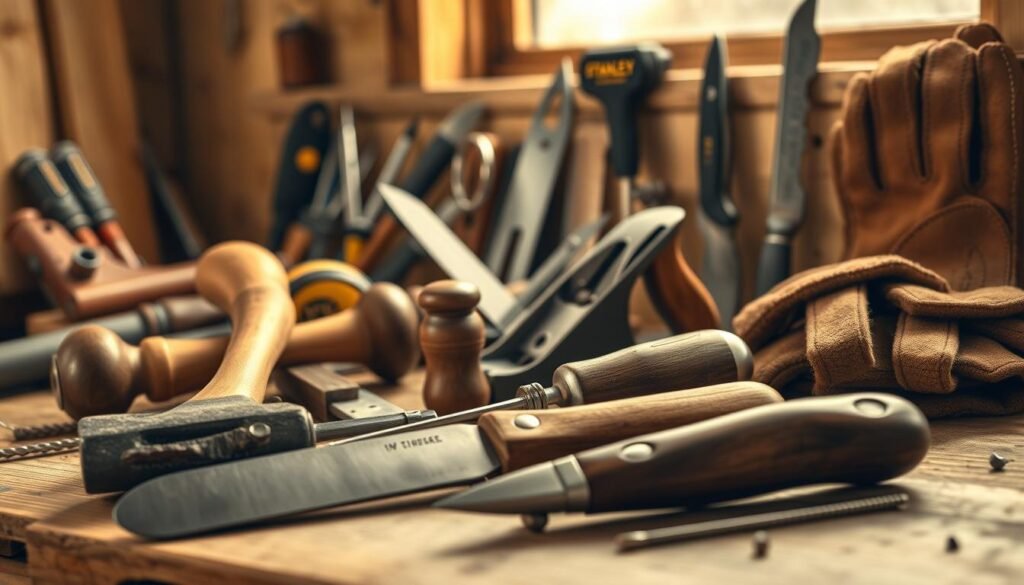
For beginners, having the right hand tools is key for a good woodworking experience. These tools help you work efficiently, safely, and with quality in your projects.
Joshua Farnsworth says chisels and hand saws are must-haves. Chisels are great for removing small wood pieces and are used for many tasks like jointing and shaping.
Hand saws are also vital for cutting wood accurately. There are different types, like rip saws and crosscut saws, each for specific tasks.
| Tool | Description | Usage |
|---|---|---|
| Chisels | Used for removing small amounts of wood | Jointing, shaping wood |
| Hand Saws | Used for cutting wood accurately | Ripping, crosscutting |
| Mallet | Used for tapping chisels and other tools | Driving chisels, fitting parts together |
A mallet is also important for beginners. It helps tap chisels and other tools without damage. Having these basic tools will help you start strong in woodworking.
Some woodworkers like to buy tools, while others make their own. It doesn’t matter how you get them. What’s important is having the right tools for good woodworking.
Discover the Best 20 Woodworking Tools for Your DIY Projects
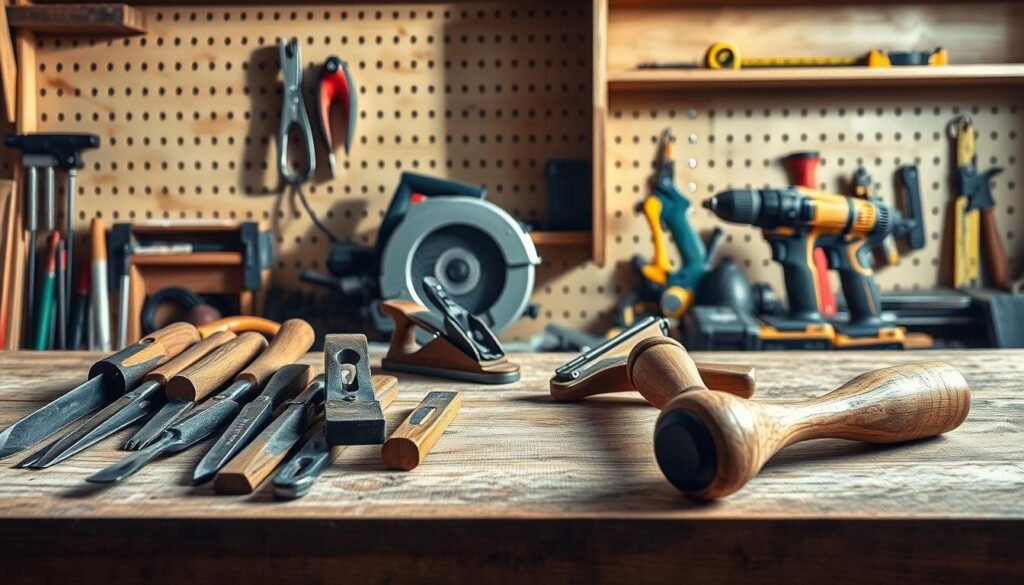
Whether you’re new to woodworking or have years of experience, the right tools are key. They help you work efficiently and bring your projects to life. Having the best tools is essential for any DIY project.
Kreg Tool recommends using jigs and fixtures for detailed woodworking projects. These tools ensure your work is precise and of high quality.
| Tool | Use | Project Type |
|---|---|---|
| Table Saw | Making straight cuts | Carpentry projects |
| Miter Saw | Precision angled cuts | Woodworking jig plans |
| Drill Press | Drilling precise holes | Woodworking shop plans |
Investing in these tools will boost your woodworking skills. You’ll be able to finish your DIY projects with precision and quality.
Power Tools That Revolutionize Your Woodworking Projects
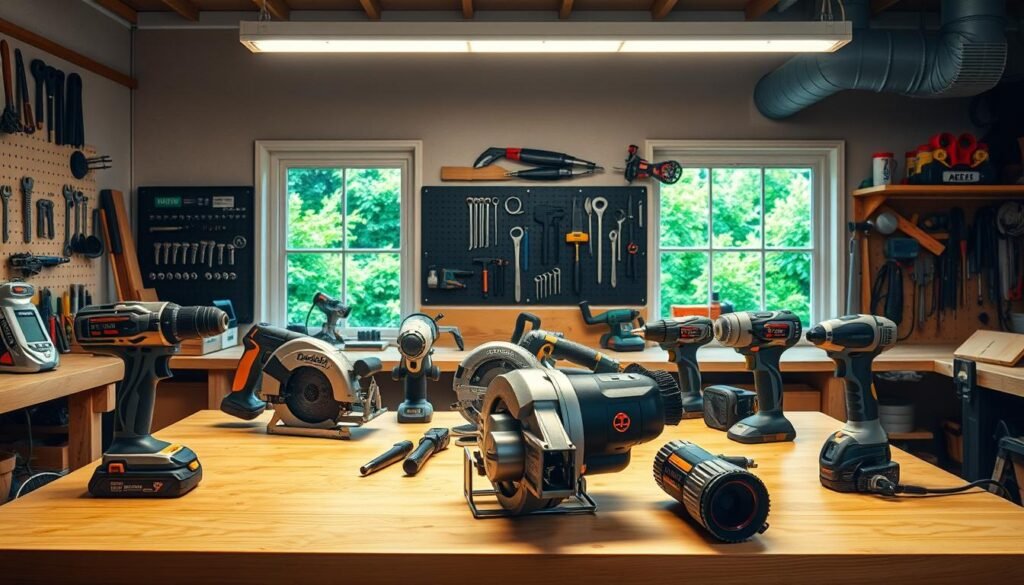
Woodworking has changed a lot with the help of powerful tools. Tools like table saws, miter saws, and routers are now key for woodworkers. They make projects more precise and faster to finish.
A good table saw is essential for any woodworking space. Look for a table saw with a strong motor, accurate fence, and sturdy table. The Kreg Tool shows how important a reliable table saw is for precise cuts. Also, think about the saw’s dust collection and safety features.
Compound vs. Sliding Miter Saws
Miter saws are vital for woodworkers too. There are compound and sliding miter saws. Compound miter saws are great for complex trim work because they cut at angles in two planes. Sliding miter saws can cut more because they move. Choose based on your project needs.
Routers, including plunge routers, are very useful for woodworking. They help with edge profiling, joinery, and more. An electric planer is also great for preparing wood and smoothing out rough lumber. Adding these tools to your work can make your projects better and faster.
Essential Sanding and Finishing Tools
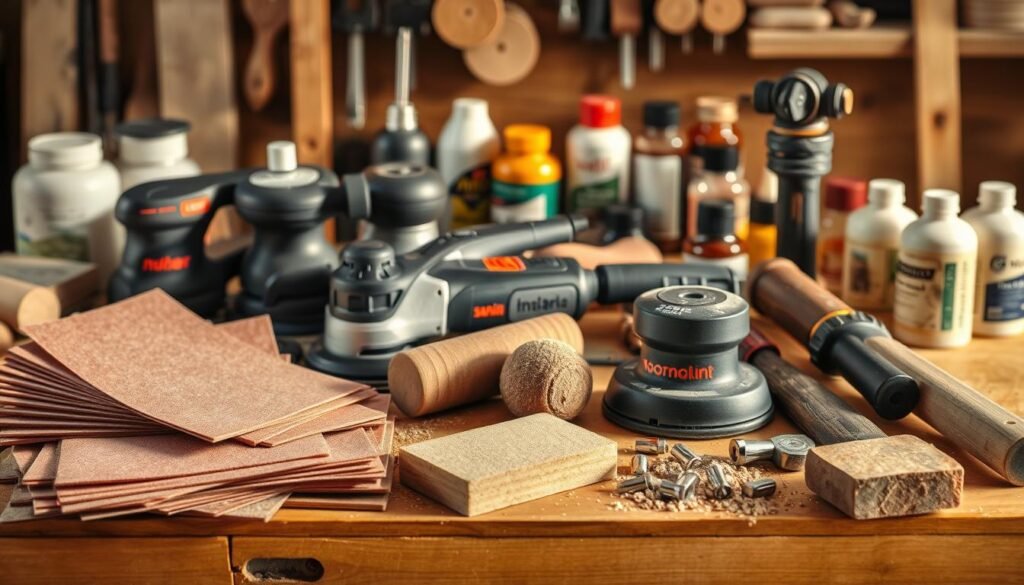
Woodworking is more than just cutting and shaping wood. It’s also about sanding and finishing it perfectly. These tools are key to getting a smooth, professional look.
Sanding removes imperfections and gets the wood ready for finishing. You’ll need sandpaper in different grits and sanding blocks for even pressure.
Shaper cutters are also important. They help create decorative edges and profiles on wood. You can find them in many profiles to add detailed touches to your work.
Finishing tools are just as important. They help apply finishes and polish the final product. Quality tools ensure your work looks great and lasts long. Investing in good sanding and finishing tools can take your woodworking to the next level.
Joinery and Shaping Tools
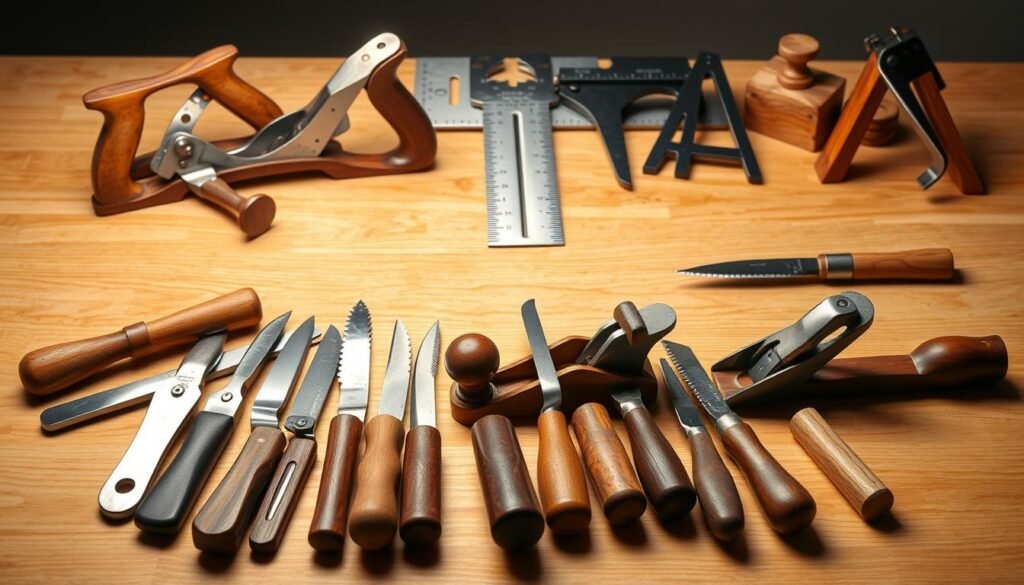
Joinery and shaping tools are key for woodworking projects. They help create detailed designs and precise joints. These tools are vital for making beautiful and useful pieces, whether it’s a small DIY project or a big furniture piece.
In a luthier workshop, these tools are used to make musical instruments with great accuracy. Routers are very versatile, used for tasks like edge profiling and making joints.
Fixed Base vs. Plunge Router Options
Woodworkers have two main router choices: fixed base and plunge routers. Fixed base routers are best for precise tasks like edge profiling. Plunge routers are more flexible, great for complex cuts and joinery.
| Router Type | Primary Use | Key Features |
|---|---|---|
| Fixed Base | Edge Profiling, Precision Cuts | High accuracy, easy to control |
| Plunge | Complex Cuts, Joinery Operations | Flexible, adjustable depth control |
Other important tools include chisels, hand planes, and coping saws. These tools help woodworkers refine their work, making precise adjustments and fine-tuning joints.
In conclusion, joinery and shaping tools are essential for woodworkers aiming to improve their craft. By knowing the different tools, including routers and their uses, craftsmen can elevate their woodworking skills.
Precision Measurement and Layout Tools
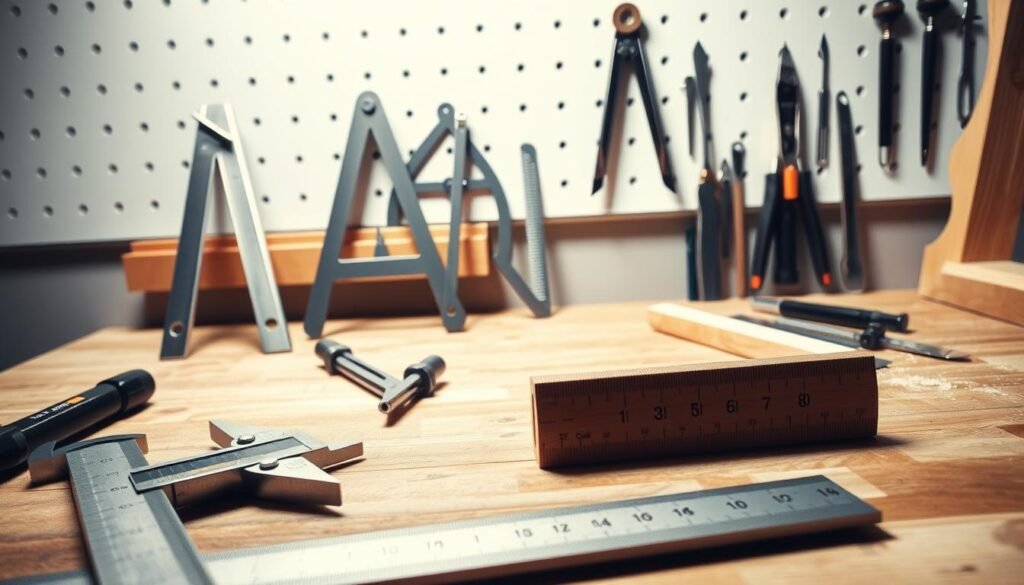
Precision tools are key for top-notch woodworking. They help avoid mistakes that waste materials and time. This makes projects better and saves effort.
Kreg Tool highlights the need for precise tools like sliding bevel squares. These are vital for correct angled cuts. Tools made from aluminum extrusion are also used. They last long and keep their shape, ensuring accuracy.
Other important tools include digital calipers, precision squares, and layout rods. They help woodworkers get the accuracy needed for complex tasks. This ensures all parts fit perfectly.
Using these tools improves the quality of the final product. It also makes woodworking easier. With accurate measurements and layouts, woodworkers can avoid costly errors and save time.
Buying good precision tools is smart for any woodworker. They are essential for creating work that stands out. Whether you’re new or experienced, these tools are vital.
Clamping and Workholding Solutions
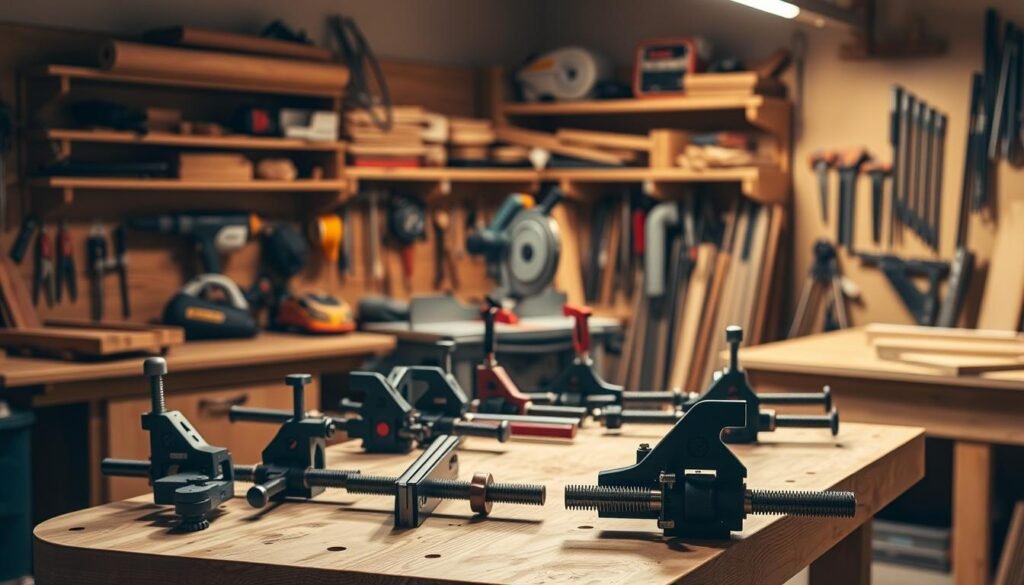
Woodworkers need strong clamping and workholding solutions for precision and safety. These tools keep the workpiece steady, making cuts and joinery accurate.
Clamps are key in any woodworking shop. There are many types, like bar clamps, pipe clamps, and F-style clamps. Each is made for different tasks. For example, bar clamps are great for big panels, and F-style clamps work well for small pieces.
A good DIY toolbox should have many clamps for various woodworking tasks. Workholding solutions like vices and hold-downs are also vital. They help with tasks needing precision and control.
| Type of Clamp | Use Case | Benefits |
|---|---|---|
| Bar Clamp | Gluing up large panels | Even pressure distribution |
| F-Style Clamp | Holding smaller pieces | Quick and easy to use |
| Pipe Clamp | Assembling large frames | Adjustable length |
Investing in the right clamping and workholding solutions boosts workshop efficiency and productivity. Whether you’re new or experienced, having the right tools is key for top-notch results.
Workshop Safety Equipment
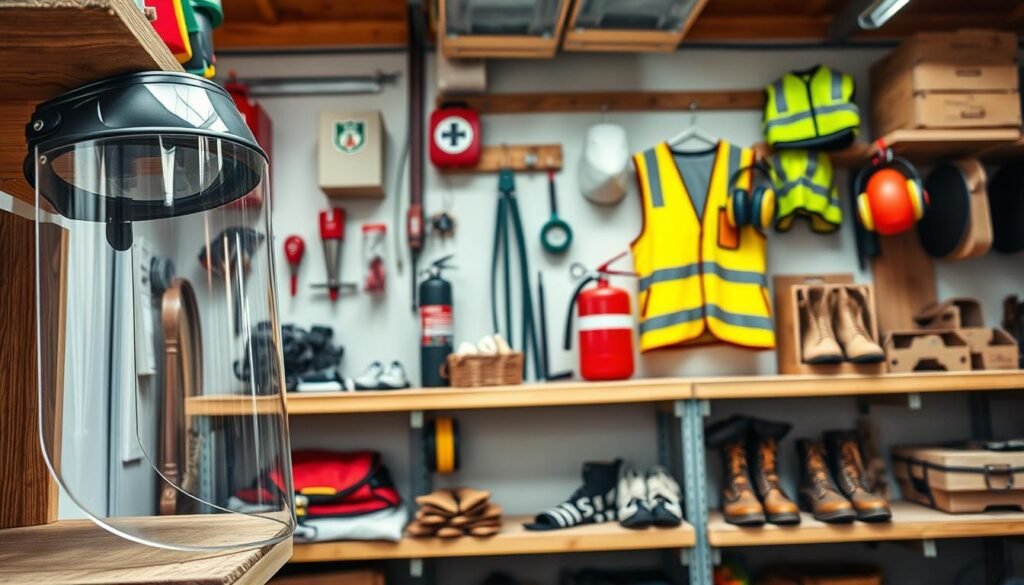
Safety is the most important thing in any woodworking workshop. The right equipment is key to keeping woodworkers safe. It ensures a safe place to work.
Portable vs. Shop-Wide Solutions
There are portable and shop-wide solutions for safety. Portable items include safety glasses, ear protection, and dust masks. These are must-haves for every woodworker.
Shop-wide solutions protect the whole workshop. This includes dust collection systems, safety lighting, and emergency stop systems for machines.
| Type | Examples | Benefits |
|---|---|---|
| Portable | Safety glasses, ear protection, dust masks | Personal protection, easy to use |
| Shop-Wide | Dust collection systems, safety lighting, emergency stop systems | Comprehensive protection, reduces risk across the workshop |
Essential Safety Gear Every Woodworker Needs
Every woodworker needs certain safety gear. Safety glasses protect against flying debris. Ear protection prevents hearing damage. A dust mask keeps dust and particles out of the lungs.
By choosing the right safety equipment and tools, woodworkers can make their workshop safer. This leads to fewer accidents and a more productive place to work.
Specialty Tools Worth the Investment
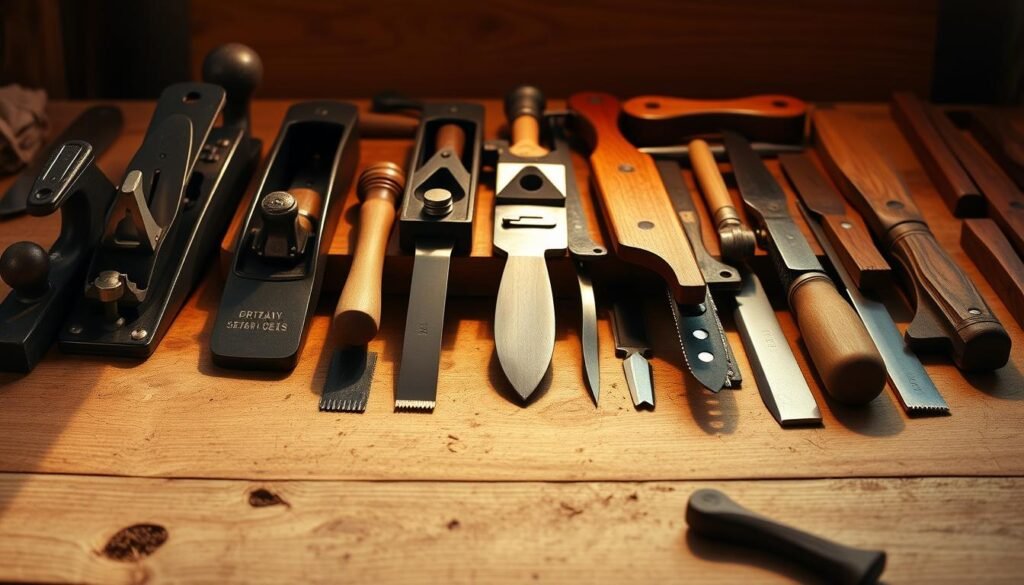
Woodworkers looking to grow their skills should consider investing in specialty tools. Joshua Farnsworth notes that these tools are not needed for every project. Yet, they can greatly improve the quality and detail of certain woodworking tasks.
These tools include unique hand tools and specialized power tools for specific tasks. For example, a veneer hammer or specialized chisels for dovetailing are very useful. Woodworkers also make their own tools, showing the community’s creativity and versatility.
Buying these tools can enhance your work and open up new project ideas. The right tool can make a big difference in precision cutting, detailed work, or achieving a perfect finish.
Choosing and investing in the right tools can take your woodworking to the next level. It’s about knowing what your projects need and being ready to invest in the tools that help you reach your goals.
Building Your Woodworking Tool Collection: Where to Start and How to Grow
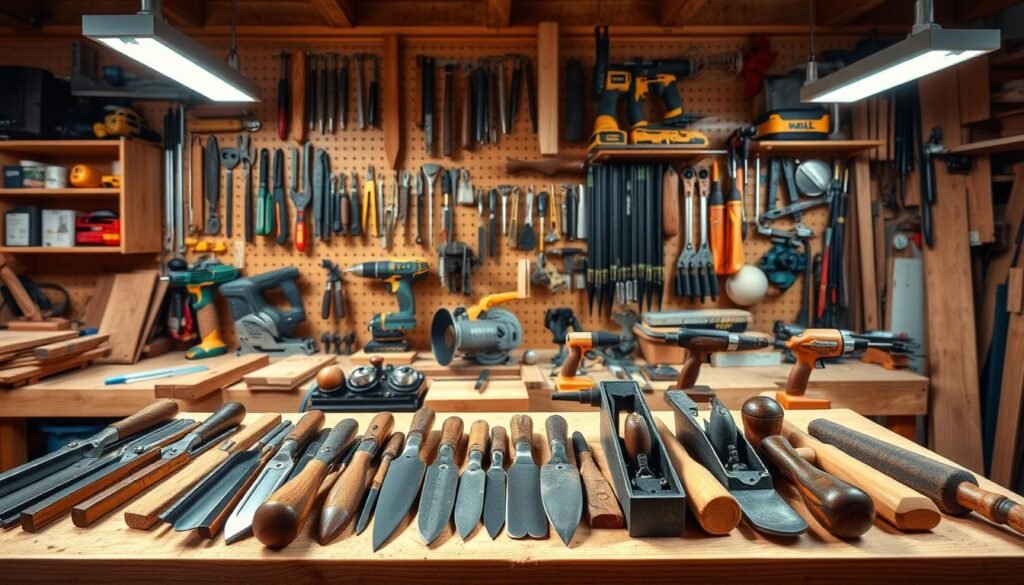
Building your tool collection is a journey. It needs patience, planning, and knowing what you need. Start with essential tools for basic carpentry DIY projects.
Kreg Tool suggests starting with basic tools and then adding more. This way, you can learn and get used to your tools before getting more specialized ones.
Think about the projects you want to do when choosing tools. For furniture making, you’ll need a table saw, miter saw, and drill press. This helps you pick the right tools for your goals.
As you add more tools, take care of them. Keeping them in good shape means you can enjoy woodworking for years to come.
Caring for Your Tools: Maintenance Tips for Longevity and Performance
Proper care for your woodworking tools is key for their long life and good performance. Regular maintenance keeps your tools working well. It also makes your woodworking projects more enjoyable.
Begin by cleaning your tools after each use. For example, a jigsaw saw needs new blades and cleaning to cut well. Keep your tools in a dry, neat place to avoid damage and rust.
Many sources stress the need for tool upkeep. Well-kept tools help you get precise results in your woodworking. Using free woodworking plans can help you use the right tools and techniques.
Check your tools often for wear and fix or replace them as needed. This way, you’ll have a more efficient and fun woodworking time.
By following these easy maintenance tips, you’ll make your tools last longer. They will also keep working at their best.

